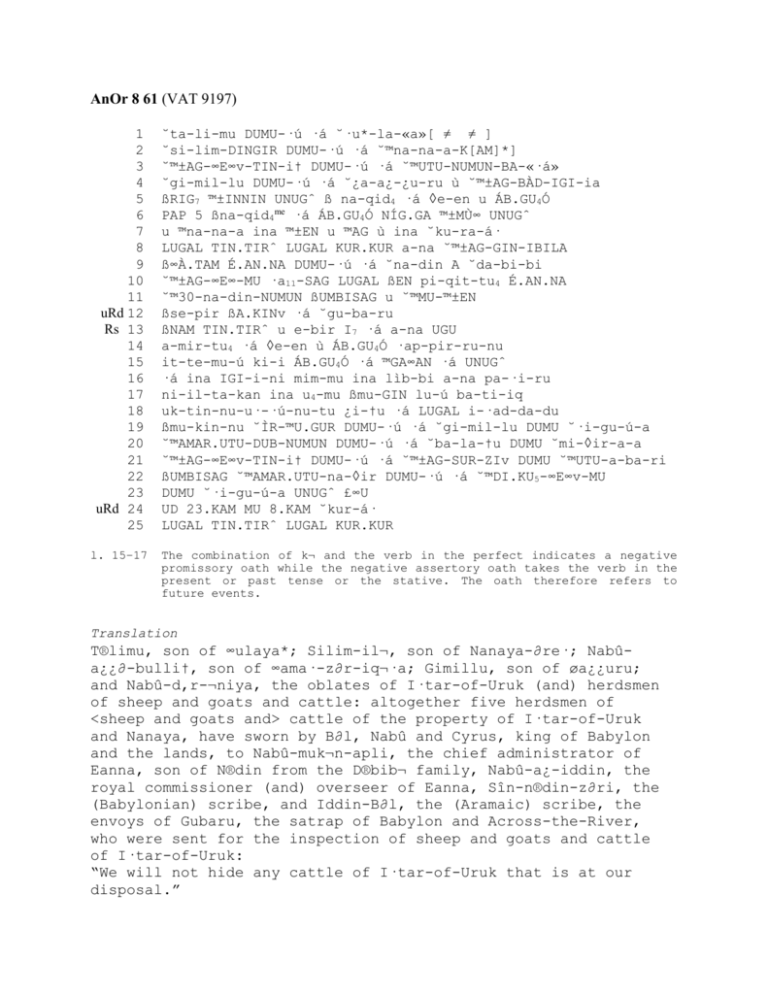AnOr 8 61
advertisement

AnOr 8 61 (VAT 9197) 1 2 3 4 5 6 7 8 9 10 11 uRd 12 Rs 13 14 15 16 17 18 19 20 21 22 23 uRd 24 25 l. 15–17 ˘ta-li-mu DUMU-·ú ·á ˘·u*-la-«a»[ ≠ ≠ ] ˘si-lim-DINGIR DUMU-·ú ·á ˘™na-na-a-K[AM]*] ˘™±AG-∞E∞v-TIN-i† DUMU-·ú ·á ˘™UTU-NUMUN-BA-«·á» ˘gi-mil-lu DUMU-·ú ·á ˘¿a-a¿-¿u-ru ù ˘™±AG-BÀD-IGI-ia ßRIG7 ™±INNIN UNUGˆ ß na-qid4 ·á ◊e-en u ÁB.GU4Ó PAP 5 ßna-qid4me ·á ÁB.GU4Ó NÍG.GA ™±MÙ∞ UNUGˆ u ™na-na-a ina ™±EN u ™AG ù ina ˘ku-ra-á· LUGAL TIN.TIRˆ LUGAL KUR.KUR a-na ˘™±AG-GIN-IBILA ß∞À.TAM É.AN.NA DUMU-·ú ·á ˘na-din A ˘da-bi-bi ˘™±AG-∞E∞-MU ·a11-SAG LUGAL ßEN pi-qit-tu4 É.AN.NA ˘™30-na-din-NUMUN ßUMBISAG u ˘™MU-™±EN ßse-pir ßA.KINv ·á ˘gu-ba-ru ßNAM TIN.TIRˆ u e-bir I7 ·á a-na UGU a-mir-tu4 ·á ◊e-en ù ÁB.GU4Ó ·ap-pir-ru-nu it-te-mu-ú ki-i ÁB.GU4Ó ·á ™GA∞AN ·á UNUGˆ ·á ina IGI-i-ni mim-mu ina lìb-bi a-na pa-·i-ru ni-il-ta-kan ina u4-mu ßmu-GIN lu-ú ba-ti-iq uk-tin-nu-u·-·ú-nu-tu ¿i-†u ·á LUGAL i-·ad-da-du ßmu-kin-nu ˘ÌR-™U.GUR DUMU-·ú ·á ˘gi-mil-lu DUMU ˘·i-gu-ú-a ˘™AMAR.UTU-DUB-NUMUN DUMU-·ú ·á ˘ba-la-†u DUMU ˘mi-◊ir-a-a ˘™±AG-∞E∞v-TIN-i† DUMU-·ú ·á ˘™±AG-SUR-ZIv DUMU ˘™UTU-a-ba-ri ßUMBISAG ˘™AMAR.UTU-na-◊ir DUMU-·ú ·á ˘™DI.KU5-∞E∞v-MU DUMU ˘·i-gu-ú-a UNUGˆ £∞U UD 23.KAM MU 8.KAM ˘kur-á· LUGAL TIN.TIRˆ LUGAL KUR.KUR The combination of k¬ and the verb in the perfect indicates a negative promissory oath while the negative assertory oath takes the verb in the present or past tense or the stative. The oath therefore refers to future events. Translation T®limu, son of ∞ulaya*; Silim-il¬, son of Nanaya-∂re·; Nabûa¿¿∂-bulli†, son of ∞ama·-z∂r-iq¬·a; Gimillu, son of øa¿¿uru; and Nabû-d‚r-¬niya, the oblates of I·tar-of-Uruk (and) herdsmen of sheep and goats and cattle: altogether five herdsmen of <sheep and goats and> cattle of the property of I·tar-of-Uruk and Nanaya, have sworn by B∂l, Nabû and Cyrus, king of Babylon and the lands, to Nabû-muk¬n-apli, the chief administrator of Eanna, son of N®din from the D®bib¬ family, Nabû-a¿-iddin, the royal commissioner (and) overseer of Eanna, Sîn-n®din-z∂ri, the (Babylonian) scribe, and Iddin-B∂l, the (Aramaic) scribe, the envoys of Gubaru, the satrap of Babylon and Across-the-River, who were sent for the inspection of sheep and goats and cattle of I·tar-of-Uruk: “We will not hide any cattle of I·tar-of-Uruk that is at our disposal.” When a witness or an informer testifies against them they will bear a penalty of the king. Witnesses Arad-Nergal/Gimillu//∞igûºa Marduk-·®pik-z∂ri//Bal®†u//Mi◊iraya Nabû-a¿¿∂-bulli†/Nabû-∂†ir-nap·®ti//∞ama·-ab®ri Scribe Marduk-n®◊ir/Mad®nu-a¿¿∂-iddin//∞igûºa Place and date Uruk, 23th day, 4th month, year 8 of Cyrus. Kozuh, Dissertation p. 105: The mandate of the royal administration to lease the Eanna’s herds, and Babylon’s continued interest in the system, meant in practice that the exploitation of those herds fell under royal jurisdiction at some level. Hence the threat of the punishment of the king or satrap is a sanction against the failure of herding contracts and attached responsibilities mandated by the royal administration. Why the royal administration may have been guaranteeing and enforcing herding contracts is discussed here, Chapter Six, pp. 262ff. p.262: IV. Animal Taxation? Both the Neo-Babylonian and Achaemenid royal administrations are found involved with the Eanna’s system of livestock management in a variety of ways. This involvement has attracted the attention of scholars since the 1940s and interpretations of it have found their way into most general histories that deal with first-millennium Babylonia. With this in mind, given my reconstruction of the Eanna’s system of livestock management, I will conclude by reassessing the evidence for Babylon’s interest in the Eanna’s sacrificial economy. Royal involvement can be detected in the following instances: • A lease of temple animals (YOS 6 155) is granted upon the command of Belshazzar the crown prince (there are parallel examples for this in temple agriculture); • There is evidence that the Achaemenid satrap Gobyras called for an assessment of the Eanna’s livestock. AnOr 8 61 mentions an oath sworn by herdsmen before the Eanna’s chief administrator, its royal supervisor, and two scribes (one writing in cuneiform, one writing in Aramaic) who are called the messengers of Gobyras (AnOr 8 61:13ff.) ša ana muḫ ḫ i amirti ša ṣ ēn (wr. ṣ e-en) u lâti (ÁB.GU4.HI.A) šaprūnu (text: šap-par-ru-nu), “who were sent for an inspection of the sheep and goats and cattle;” • Also in Cyrus’ fourth year AnOr 8 43 reports the following command from this same Gobyras to three herd supervisors: attunu napḫ ar nāqidī ša rēḫ i ša muḫ ḫ ikunu ittikunu tabbaka (text: ta-ab-ba-ku) ana pan Gūbaru ittini tallaka(text: tal-la-ku), “you (pl.) will bring in with you (pl.) all the herdsmen with balances that are owed by you (pl.) and go to Gobyras with us;” • YOS 7 39, which almost certainly mentions Gobyras’ Eanna contact Gimillu the ša muḫ ḫ i rēḫ āni in line 67,22 lists the balances (rēḫ u, pl. rēḫ ānu) of the herdsmen under the herd supervisor (rab būli) Ibni-Ištar for Cyrus year 4; • A similar tablet, YOS 7 83, listing the balances of the herdsmen under the herd supervisor Arad-Bēl, almost certainly dates to Cyrus year 8; • Gimillu continues in his function as ša muḫ ḫ i rēḫ āni through at least Cambyses year 6; • In Cambyses year 2 three texts mark specific extractions of animals and animal products for the king (see here, pp. 266ff.); • The threat of the punishment of the king or Gobyras—whatever it may have meant in practice—is found associated with livestock management (and indeed other aspects of the Eanna’s economic life) throughout this time period. This royal interest in the Eanna’s livestock management is certainly best viewed in light of the royal interest found in contemporaneous systems of temple agricultural management. Pierre Briant summarizes this latter aspect of royal involvement as follows: Nabonidus, assisted by his son Bēlshazzar, introduced modifications [in temple agriculture management] that in general were not rescinded by Cyrus and Cambyses. In order to gain tighter control over such strategic financial powers and to improve agricultural profitability, the royal authority decided to play a direct role in the economic activities of the Babylonian temples under its control.23 Along these lines I believe it is possible to ascertain in what manner, and then to postulate to what end, Babylon attempted to assess and influence the Eanna’s system of animal husbandry. That is, if we take for granted that the royal authority decided to play a direct role in the economic activities of the Babylonian temples under its control, then the next step should be to determine what that role was (and was not) and its intended results. As I see it the evidence for royal involvement in the Eanna’s system of animal husbandry falls into two categories. First, there is substantial evidence, from the reign of Nabopolassar onward, that the crown was continuously feeding animals into the Eanna. This occurred under a variety of rubrics: ešrû, irbu, ṣ ibtu, and bīt ridûti and the sheep of the royal offerings (which were donated by various royal/municipal officials, see here, Chapter Four, pp. 178ff.).24 According to Dandamaev the Eanna used cattle and sheep delivered as ṣ ibtu for “sacrifices on behalf of the king,”25 and indeed it is possible that the bīt alpi ša šarri,“cattle house of the king,” which is referenced in a few texts,26 was established to administer such royal offerings. Yet in YOS 7 8:8f. sheep from the bīt ridûti and the royal offerings are counted as debits (i.e., intake) for the offering shepherd, but the corresponding credit (outlay) section does not make particular mention of a special series of royal offerings. Nor, for that matter, are royal offerings included among the irregular secondary offerings in tabular sacrifice texts.27 It thus appears that the royal offerings were included in the regular sattukku offerings.28 It is also possible that royal cattle offerings were managed separately. Whatever the case may be, YOS 7 8, which audits the offering shepherd from the fifteenth year of Nabonidus until the first year of Cyrus, suggests that the Achaemenid administration continued to feed animals into the Eanna.29 Indeed the bīt ridûti and the sheep of the royal offerings constitute twenty percent of the total number of animals that the offering shepherd collected during this period. Second, we find Babylon directly involved with the management of rēḫ u and the harvesting of the Eanna’s own animals. The evidence for the former is detailed above: Gobyras, the Achaemenid satrap, orders a reckoning of the Eanna’s animals and later issues an order for the nāqidū ša rēḫ i to appear before him. We also know that one of Gobyras’ contacts at the Eanna, Gimillu the ša muḫ ḫ i rēḫ āni, was directly involved withthe management of rēḫ u, which resulted in a series of tablets that lists the rēḫ u in animals and fiber of hundreds of herdsmen. This Gimillu also tracked down recalcitrant herdsmen and involved himself in extracting animals. In fact his heavy-handedness perhaps due to his royal connections, and possible deception and abuse of power, may have resulted in local animosity against him. Moreover we find the threat of the punishment of the king and/or the satrap Gobyras used to secure transfers of sacrificial animals from the herdsmen to the temple, and I connect this to the royal mandate under which some herdsmen held the Eanna’s animals (see here, Chapter Three, pp. 104f.). If indeed there was a royal policy to gain greater control over the temples, or simply to encourage greater profitability, then empowering local contacts or mandating crown retribution in order to obtain certain results might have been one practical application of that policy. What we do not have evidence for is regular royal extractions of livestock from the Eanna. Particularly, nothing counterbalances the evidence that the royal administration regularly gave animals to the Eanna. Three well-known texts (GCCI 2 120, YOS 7 123, and AnOr 8 67) do mention the extraction of some animals and animal products for the royal administration, but, as has been noted, these three texts refer to one unique event.30 Even with that in mind, these texts have been consistently misinterpreted since San Nicolò’s original editions of them, and, given their historical importance and relevance to the topic at hand, I offer a revised interpretation here.31 GCCI 2 120 (Cambyses, 12-VIII-02) refers to a message from Gobyras (šipirtu ša Gūbaru) calling for the upper-level temple management to entrust eighty sheep and goats, the property of Ištar of Uruk, from the bīt urî to Zērija/Nanā-ēreš, who is certainly the herd supervisor of that name. Zērija is to send the animals to the chief administrator and royal supervisor of the Eanna at the still-unlocated royal palace at Amanu (also: Abanu) for the šuṣ buttu (“provisioning”) of the king. This transaction is odd because it reverses the normal course of events. Zērija, the herd supervisor, is taking animals out of the bīt urî, whereas he and other herd supervisors usually arrange for transfers of animals into the bīt urî. This text does mark a real transfer of assets from the Eanna to the royal administration, but it was exceptional. Furthermore we also have evidence for the royal administration paying animals into the bīt urî on a regular basis. There is no evidence that the bīt urî bred animals, so it seems reasonable to assume that this transaction was in male animals and therefore did not represent a loss of animal capital for the Eanna. YOS 7 123 (Cambyses, 25-VIII-02), written thirteen days after GCCI 2 120, mentions two separate transactions: in the first (lines 4-10) the herd supervisor Arad-Bēl/Šarru-kīn is obligated to provide hegoats and young male goats (lines 4f.: MÁŠ.GAL.MEŠ ù MÁŠ.TUR.MEŠ) to the chief administrator and royal supervisor of the Eanna at this same Amanu for no stated reason, but presumably connected with the šuṣ buttu mentioned in GCCI 2 120; in the second (lines 11-13), Arad-Bēl agrees to pay (eṭēru) sheep and goats and lambs (UDU.NITÁ.ME ù SILA4.ME) for the offerings for the month of Kislīmu (month IX). As is noted in this dissertation and elsewhere, goats play a very minor role in the Eanna’s animal economy. Although this text again references an extraction of (male) animals out of the Eanna, it is not of a type that affected the sacrificial economy, nor for that matter was it a loss of animal capital for the Eanna. Finally, AnOr 8 67 is also unique. It dates to Cambyses 28-VII-02, just before the date of the prior two texts, so it certainly refers to the same event. In this text, which mentions a message from Parnaka,32 both Zērija and Arad-Bēl are obliged to bring and set up (lines 4f.) 100 U 8 ù UDU.ÙZ šá ši-zib, “one hundred ewes and she-goats of milk.” As van Driel notes, ša šizbi (“of milk”) here must refer to the fact that these ewes and she- goats are lactating.33 In other words they are not to be slaughtered, but instead are to produce milk for the meal of the king (naptanu ša šarri, line 8), perhaps to be consumed as such or made into cheese or yogurt. This is reflected in the language of the text. The two herd supervisors are to bring and station (abākuma ... šuzzuzzu, lines 7-9) the ewes,whereas animals that are led to the slaughter are brought and given (abākuma ... nadānu). Although this is an extraction of sorts from the Eanna, it was obviously temporary and of an expendable product. I am not attempting to discount the fact that these three texts do mark real extractions of temple animals and animal products from the Eanna for the royal administration. Nonetheless they refer to a one-time event, and even then GCCI 2 120 refers to the extraction of animals by a unique process, YOS 7 123 refers specifically to goats, which were peripheral to the Eanna’s economy, and AnOr 8 67 refers to a temporary use of some of the temple’s female animals. These are extractions of a unique sort, but they were taken from the extreme margins of a much larger economy. Thus, apart from these three texts, I know of no other texts marking the transfer of livestock out of the Eanna to the royal administration. Unlike the general contracts on which most of the Eanna’s orchards and grain fields were leased out, the livestock share-breeding contract YOS 6 155 does not call for payments to be made to crown or municipal officials.34 Royal extractions are absent from the four temple audits of its various livestock handlers (NBC 4897, YOS 7 143, YOS 7 8, YOS 7 74), and in fact two of these audits mention significant inputs of animals from the royal administration.35 There are admittedly no published audits of the bīt urî or any of its departments, but there is evidence that the royal administration added animals to the bīt urî’s stock as well.36 Not only do we see both the Neo-Babylonian and Achaemenid administrations routinely feeding animals into the Eanna’s livestock pool though a variety of channels, we also see Babylon actively working to organize the Eanna’s animal bookkeeping and enforce the procedures by which those animals were delivered to the temple. If indeed all this is the manifestation of Babylon’s direct role in the economic activities of the Babylonian temples, then it can be said outright that the aim of this role in terms of animal management was not simply to siphon off animals as tax for the royal administration. In general, taking the evidence as a whole, we have full, and often overlapping, knowledge of how and when the temple assessed and harvested its animals, from their birth until death. As the situation stands today there is no evidence for regular taxation in live animals. Moreover the evidence for irregular royal extractions of live animals is dwarfed by the evidence that Babylon regularly gave animals to the temple. What may prove to be the most fruitful approach toward understanding the royal administration’s involvement with systems of temple agriculture and livestock management may be found at the other end of the spectrum, in what we may loosely term investment and manufacture.37 If we assume a deliberate royal policy of encouraging greater exploitation of, or even adding to, the animal resources available to the temples,but do not have corresponding evidence for outright extractions from the raw results of that increased exploitation, then it is possible that the aim of that policy was actually to increase existing capital, production, and manufacture in an effort to extract taxes (under whatever rubric) from the temple in the form of finished products. For example, the royal administration may have added animals to the temple’s stock and aided in enforcing the procedure by which the Eanna collected animals, wool, and hides in an effort to see an exponential growth in animal consumables; this growth would then allow the royal administration to extract from the finished products of the Eanna’s already existing butchering, tanning, and textile manufacturing processes. For butchering, this would entail redistribution of the king’s share of meat cuts to local supporters though the prebend system;38 for hides and wool, some might also have been filtered through the prebend system, but, the products being long-lived, movable, and storable, the temple’s industrial-level textile manufacturing processes were probably best exploited through other channels. This could be done in a variety of ways: outright taxation, utilization of various redistribution channels set up for the king (e.g., the quppu ša šarri39), or even through trade. This is indeed a complex set of problems, and scholars are only now turning their attention toward the prebendal and secular distribution of temple products. Whatever the case may be, following up on these lines of inquiry is obviously many volumes in the making. Cornelia’s comments: AnOr 8 61. Five herdsmen who taken an oath to the nabu twin, the highest temple officials put to two envoys of Gubaru, that they will not hide any cattle of the temple that are at their disposal. This tablet makes no sense as a negative promissory oath because that would not require the clause if someone testifies against them. It only makes sense if they previously denied something. The interest of the royal administration are somehow involved because we have these envoys. And it must of some import to involve all these people. But it is not a routine audit sign off, and it is not a routine promissory sign off. The five herdsmen are under suspicion, and all the guys came out to inspect the cattle. They may still be under suspicion. So, if someone does come forward then administrative sanctions. The suspicion is not steeling, but hiding the babies or putting something aside for them. Embezzlement? The problem is the Gimilu texts because he is constantly . What if they are not just any cattle, but cattle that is supposed to be delivered for some sort of offering? Then the violation is not theft per se or embezzlement per se, but failure to treat specific cattle in some specific way for delivery. In Kozuh, “Sacrifical Economy,” his dissertation p. 20 (check pages because cornelia may have two versions). He says that our information about inspections (amirtu) of sheep and goats are fragmentary. We have the amirtu word in our text, but it is not an amirtu per se. Rather it refers to amirtu. Amirtu is associated with estimations of wool. Kozuh has connected about 560 text that refer to administration of Eanna’s livestock, utilization of livestock products, the personnel involved. Prior scholarship is San Nicolo Viehwirtschaft p. 22ff. Van Driel, “NB Sheep and Goats,” the whole article. Van Driel divides into two categories internal and external spheres. Kozuh also deals with this in more detain. Cornelia has the Van Driel in the Biblio. She does not know the envoys. Problem: Conditional administrative sign-off not possible because of verbal form, it is a promissory oath not an assertory oath. This was my mistake, I am sorry. So, why is a hitu applied to a promissory oath? Certainly this does not fit into KK’s perjury model. She does not address it. Kozuh says miltu inspections occur typically when the composition of the flock is altered. The herds are brought in. It is not done on a regular basis, but when a new herd is started and registered. Then it is a possibility that the promissory oath is meant. They start out with this promise. Or if this is a special inspection, it makes sense that they promise that they will not hide anything in the coming inspect. Cornelia suggests that it is also possible that this promissory oath is meant to be both assertory and promissory. Cornelia would prefer to read an assertory oath, and they give it to the people who are going to do the inspection. This is not, however, a likely scribal error because the verb is in the perfect. The whole interpretation rests upon the interpretation of the oath—does it apply to past or future events. We don’t have a problem with this being a promissory oath—we have lots of promissory oaths in hitu texts. The problem is the existence of the conditional verdict with the promissory oath. These just don’t go together. So, it makes sense that the oath was meant to be a assertory oath in the past. Ni-il-ta-qan instead of ishkantan or nishakan. Oops! Autopilot error (like the text with the 15th day)? We collated the tablet. Sigh! SOLUTION!!!!! Shalom Holtz (diss) suggests that AnOr 8 61 was probably “issued as part of the formal proceedings in which both the accusation and the declaration in response were made.” P. 172. This text records and inspection that may have been prompted by a theft or accusation of theft. But the herdsmen in this text are responsible in this text that a thorough and proper inspection can be done. Their oath, therefore, certifies that they have not interfered in the inspection by hiding any of the livestock in their charge. We have reason to believe that their oath is an assertory oath about this matter about the inspection. First, the type of conditional verdict that ends the text occurs only when questions about past actions when arisen [Rachel needs to add a line about how verdicts, be they conditional or final MUST be about past actions.] Second, while it is true that most assertory oaths do not employ perfect verbal forms, evidence exists that they can. For example, YOS 7 140 records an assertory oath that begins with the usual work ki and ends with apteqid. See, Holtz, pp. 94-96. Cf. Dar 260:21 (might have a perfect form in an assertory oath as well—it may not be the best example). Rachel and Bruce’s old remarks: Second, many of the sin-of-the-king cases involve quite ordinary matters of administration, such as the care of cattle (e.g., AnOr 8 61, PSBA 38 pl. 1) Two of the oaths are sworn by Bel, Nabu, and a king: AnOr 8 61 (Cyrus); and YNER 1 2 (Darius). On the other hand, AnOr 8 61, PSBA 38 pl. 1, YNER 1 2, YOS 7 50, YOS 7 85, YOS 7 123, and YOS 7 192 contain “a sin of the king”; YOS 7 116 contains “a sin of Cambyses”; and YOS 7 160 contains a “sin of Gobryas.” Lastly, we address AnOr 8 61, a text that looks somewhat different from the others discussed above. Despite the apparent differences, the subject of the record is an accounting of the temple livestock, as we have seen before in TCL 13 137 and PSBA 38 pl. 1. In AnOr 8 61, four important officials pay a visit to five slaves, who are working as herdsmen for the Eanna, for the purposes of making an inspection of the livestock in the care of these herdsmen.i The party of officials consists of Nabu-mukin-apli, Nabu-ah®h®e-iddin, Sin-nadin-zeri (identified as a scribe, presumably a temple scribe), and Iddin-Bel, a representative of Gobryas. In the presence of these officials, the five herdsmen swear an oath, in which they assert that during the inspection, they have not hidden any of the cattle from the view of the inspecting officials.ii The text concludes by stating that, if a witness ever comes forward and testifies that the herdsmen did in fact conceal cattle from the officials, the herdsmen will “bear a sin of the king.” We maintain that this statement does not mean that the herdsmen will be guilty of theft, because in that event, they would have been punished with a fine equal to a 30-fold penalty.iii Consequently, we believe that AnOr 8 61 is not a case of suspected theft. Rather, it constitutes a type of audit signoff that was probably a regular administrative affair.iv If someone should come forward with knowledge that there were irregularities during the inspection, the herdsmen will be found guilty of violating their administrative duty to care and account adequately for the cattle. In this instance, too, to bear a sin is to violate duties owed to administrative superiors. i See San Nicolò, “Materialien zur Viehwirtschaft…II,” 295-99; and Dandamaev, Slavery in Babylonia, 511, 545. ii This interpretation of the text differs somewhat from that of San Nicolò and Dandamaev (see n. 135, supra). We take the oath as an assertory oath; they understand it to be promissory in nature. Because the verb in the oath is a perfect form, we believe the herdsmen are asserting that they have not done something in the past rather than that they will not do something in the future. See further Wells, Law of Testimony, 74 n. 85. iii Wells, Law of Testimony, 109-13. iv See, e.g., AnOr 8 30, which appears to be a similar audit sign off on rent collections.




